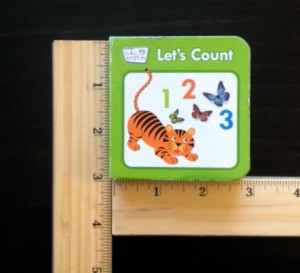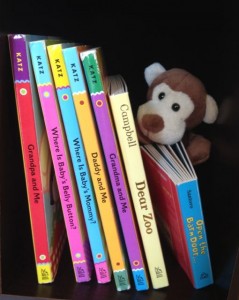Baby Einstein 12-book library review
Many educators and parents disapprove of the Baby Einstein products. While I have not picked up any of their videos because of mixed reports of their actual educational value, I have bought some of their books and music CDs for my daughter, and she has enjoyed them.
One concept I liked was the Baby Einstein 12-book library. This is a set of 12 books, and each book is about 3 inches tall, 3 inches wide, and an inch thick. The size makes it easy for toddlers to hold a book and turn pages. The recommended age group for this product is 10 months to 3 years.
Each book has a theme. For example, the “Colors” book shows objects of different colors. On the “Blue” page, there are pictures of blueberries, blue socks, a blue crayon and other blue items . My daughter has enjoyed looking at the different objects under a particular theme.
However, I think this good product could be made even better by addressing the following issues. Continue reading
LEGO: A learning tool for toddlers
A mom I recently met said she doesn’t let her two-year-old play with lego because it involves too much post-play cleaning. I have a toddler myself so I understand her concerns of a messy house.
However, I think there are a couple of reasons why building blocks may just be worth the trouble.
1. Motor skills — Kids use their fingers to pick up pieces of lego and place one on top of the other. This builds their fine motor skills. Sometimes, they need to hold the towers they build steady with one hand when they place the next block on top. This develops coordination and balance.
2. Mental processes — Lego helps kids be creative and use their imagination. Toddlers create bridges, towers and use lego wheels to make cars, while older kids can build spaceships, castles and houses. I’ve noticed that my 2-year-old uses her lego for different things. She makes prints on play dough with different lego shapes. She uses the open side of the pieces as little bowls to fill cheerios and other small objects. She even takes a few in the bath tub to fill and pour water. She places little stuffed animals in her lego car and pushes them around the house.
When kids build, they have to think about process (“First I should put this block on the table, and then place the other on top. Once that is done, I can place yet another block on the second”). Continue reading
Study Abroad: Getting your transcripts
This is the last post of the Studying Abroad series.
Most foreign universities will ask for your transcripts. Transcripts are official records of your academic performance, signed by your college registrar, sealed by your college and bearing your college’s official stamp. It is very important to remember that report cards are not substitutes for transcripts and will not be accepted by the foreign university.
The first thing you should do is look up the requirements on the foreign university’s website. How many transcripts do they need? Do they want your college to send it or can you collect them from the college and then send it yourself? What is the deadline for receiving the transcripts?
Visit your college and ask the office what the procedure is for getting transcripts. Don’t expect it all to happen in one day. You will probably be told the time and day that you can pick them up. Ask what they need from you (report cards, ID etc). At this point, you will probably have to pay for the transcripts in cash or be asked to bring a cheque the next time you come. Continue reading
Study Abroad: Taking the GRE, GMAT, TOEFL, SAT, IELTS and other exams
An important step in gaining admission to a US, UK or Australian school is taking a standardized test. This post highlights the steps to taking such exams, some challenges foreign students may face, and how to meet these challenges.
Which test should I take?
Visit the website of the school where you seek admission. You will find information on which exam(s) you are required to take.
What should I expect?
Some of these exams test you on math and English, others only on your English language skills (vocabulary, reading comprehension, listening skills etc). There are some things you should know.
Format of tests: Most of these exams are computer-based or Internet-based. While US students are used to giving tests online, many Indian students may find this a new experience. When you study for the test, take as many practice tests as possible on the computer.
Content of tests: Sometimes, the English sections of the GRE and GMAT ask you to learn the meanings of a number of words with Greek or Latin roots. In the reading comprehension section, you may have to answer questions on topics you have never read about before such as American politics or American history. Additionally, the math may be a little different from what you have done before as well. Don’t be intimidated. Taking practice tests should familiarize you to the content. Try to read articles from American news sites such as the New York Times or the Washington Post, or read features from the National Geographic website. They will help you get the feel of American English, as well as expose you to different types of content.
Most cities have preparation classes that will help you study for the exam. Classes will familiarize you to the concepts and formats, but you must practice at home to really seal the deal. If you choose to not attend preparation classes, you can buy the necessary textbooks from your nearest bookstore or order them online. Continue reading
Study Abroad: Getting your Letters of Recommendation
I’ll be writing a series of articles on the experiences and challenges that International students face in order to get into an American university. Most things that American students take for granted such as the ease of getting letters of recommendation, ordering transcripts, and scheduling appointments for the SAT or GRE, can be downright painful for students in India or other countries.
Today’s post is on the challenges Indian students may face while trying to get their letters of recommendation for a U.S. university.
Here are some of them:
1. Conveying the importance of recommendation letters - Few Indian universities ask for letters of recommendation when you apply for admission, so your professors may not be aware of or understand the urgency of getting these letters to you.
Solution - Start early. If you know you will need someone’s recommendation in two months, ask for it NOW. In your email, stress on how important a good recommendation is to get into a university abroad. If they do not reply in a week or so, try again. They may have missed your email. Continue reading
The Bird and the Bees — a short story
Once upon a time, there lived a fairy in the woods. Her house was in a tree and it had a tiny white couch in the living room, and a tiny white bed with yellow covers in the bedroom. She had a pretty pink bathroom with a gold-framed mirror in it. She also had a little garden just behind the tree, with potted flowers. The fairy was very proud of her garden and its colorful flowers.
She lived with a roommate because renting a tree in the heart of the forest was expensive. Her roommate was a kind bluebird, who ensured that he went to the bathroom on the fairy’s pretty pink potty and not on other people’s heads like the birds of the city do. Continue reading
Why do Kids love Flap Books?
When I was reading to my daughter today, I started wondering why toddlers love flap books. Many people think that it is because flap books are similar to the peekaboo game. Sure, flap books and peekaboo share an element of surprise. However, the peekaboo game depends on object permanence i.e. the understanding that objects continue to exist even when they are no longer visible. So when a child sees your face, and then you cover it, she knows that if you remove those hands, that face will reappear.
On the other hand, when toddlers lift the flaps in books, it seems to be more about discovery. What will they find under that flap? Oh, it’s an elephant! How exciting! What will be under the next flap? Continue reading


